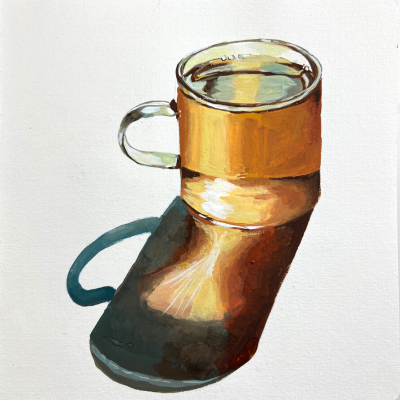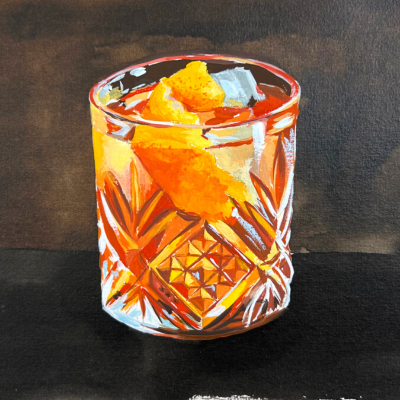The Beauty of Glass Painting with Gouache
With its transparent allure and reflective surface, glass presents a unique dance of light and color that can be a thrill to capture. But let’s be honest; it can also be intimidating, especially if you’re starting.
Table of Contents
- Why gouache?
- Essential Tools for Glass Painting with Gouache
- Unveiling the Techniques: Painting Glass with Gouache
- Five tips for painting glass with gouache
- Conclusion
Why gouache?
As an art teacher, I’ve had a chance to experiment with various mediums and developed a particular fondness for gouache. It’s not too overwhelming like oil or subtle like watercolors – it’s just right!
Gouache paints are wonderfully versatile. They provide the best of both worlds with their opaque and vibrant color, like acrylics, yet have that gentle watercolor-like blendability.
But gouache shines through in its ability to capture depth and luminosity, especially when painting reflective surfaces like glass.
Now, before we jump on the gouache bandwagon, a little caveat – gouache can sometimes be a tad temperamental. It dries fast, and learning to control its opaque nature can be a learning curve. But hey, what’s art without a dash of challenge, right?

Essential Tools for Glass Painting with Gouache
Here’s what you’ll need in your toolkit for this venture:
- Gouache Paints: Look for a good quality brand with vibrant pigments and smooth consistency. Trust me, initial investments in high-grade material never go in vain! I rely on Holbein, but brands like Winsor & Newton or M. Graham are also fine. Feel free to choose what fits your budget and preference.
- Brushes: A flat brush and a medium-sized round brush are a great start, and remember a fine brush for those delicate details.
- Palette: Any flat surface can act as a palette. A palette with wells can come in handy to mix your colors. Or you could get all artsy and go for a traditional wooden palette – there really are no rules here!
- Glass Surface or Photo Reference: If you’ve got a piece of glassware handy, great! If not, a clear, high-quality picture should serve just as well. I suggest having a black-and-white version of your reference image to see the values better.

Unveiling the Techniques: Painting Glass with Gouache
- Understanding the Nature of Glass
Here’s the thing about glass – it’s not just about its physical form. It’s about how it interacts with light. Glass isn’t truly transparent; it captures, bends, and reflects light, creating stunning effects that can be a joy to capture on canvas. Plus, it’s about the shadows and highlights, the tints, and how colors around the object can influence its appearance.
2. Applying Gouache: Layering and Blending
In my journey of creating art with gouache, I’ve learned that it’s all about layering and blending. Start with thin, light washes of color, adding depth and richness as you layer. Don’t rush it; let the paint dry between layers to avoid unwanted smearing.

3. Attention to Detail
As they say, the devil’s in the details, and this couldn’t be more accurate when painting glass. Observe your reference carefully, and note even the smallest reflections, color shifts, and contours. Every tiny detail you add brings you one step closer to a realistic render.
It can help you to paint upside down to trick your brain. This way, you are really painting what you see and not what you think it is.
4. Mastering Reflection & Transparency
Now, here’s where the magic happens – mastering reflection and transparency. This can be the trickiest part, but boy, is it rewarding! A soft gradient from light to dark can give the illusion of a reflective surface, while cleverly placed highlights simulate transparency. Practice will make you proficient here, pal!
To better show the transparency of glass, having a colored background is helpful. It can be painted with gouache or acrylic, or you could even use colored or black paper.

5. Practice & Patience
Ah, the timeless principles of any art form – practice and patience. It’s okay to make mistakes. It’s okay if your first few attempts don’t turn out as you want. Remember, we’ve all been there, and every great artist started as a beginner. So, keep practicing at your own tempo.

Five tips for painting glass with gouache
- Understand Light and Shadow: Glass is transparent, and its appearance largely depends on light, shadow, and what’s behind it. Get familiarized with these elements. Note how light passes through glass, creates bright highlights, and casts shadows. Draw a carefully observed sketch considering these aspects.
- Use the Right Colors: Start by painting the shade and highlighted areas with the color they appear to be rather than the color you think they should be. Glass will often reflect the colors of nearby objects. Use a limited palette of colors to maintain harmony in your painting and to avoid muddiness.
- Establish Mid-tones First: Lay down the mid-tones of the transparent glass as your base, painting the interactions between light and surface. Adding the highlights and shadows in later layers lets you build up the image progressively and have a clearer sense of values.
- Work on the Reflections and Refractions: These are essential to depict glass convincingly. Reflections are the light and images that bounce off the glass from the outside. Refractions, on the other hand, are distortions or changes in the angle of the light as it passes through the glass. Carefully observe and include these in your painting.
- Add Details and Refine: Use a fine brush to add the final details, like the brightest highlights, which give life to the glass. Gradual and subtle transitions between the tones help suggest the smooth surface typical of glass. The final touch is painting the highlights with an opaque white like Titanium or Permanent white.

Conclusion
And there you have it, my dedicated friends, your essential guide to painting glass with gouache. If you want detailed videos on how to paint glass with gouache, this is our monthly topic in my Gouache Membership.






